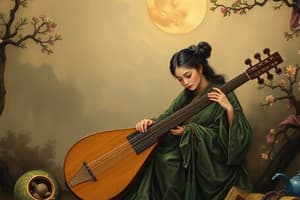Podcast
Questions and Answers
What is one of the practical uses of music for Chinese people?
What is one of the practical uses of music for Chinese people?
- To decorate public spaces
- To entertain foreign visitors
- To teach guidelines for behavior (correct)
- To emphasize historical events
How does music function in relation to the government in China?
How does music function in relation to the government in China?
- To offer entertainment during government events
- To provide financial support to artists
- To give power to the government (correct)
- To distract the population from political issues
In what way does music facilitate social relationships in Chinese society?
In what way does music facilitate social relationships in Chinese society?
- It is a medium for dissent against the government
- It is utilized in formal ceremonies only
- It helps in reaching agreements and cooperation (correct)
- It serves as a form of individual expression
What aspect of music reinforces social structure in China?
What aspect of music reinforces social structure in China?
What is a social aspect of music in the context of Chinese culture?
What is a social aspect of music in the context of Chinese culture?
Flashcards
Chinese Music's Purpose
Chinese Music's Purpose
Chinese music serves practical functions, guiding social behavior, supporting the government, and facilitating agreements.
China Music Function 1
China Music Function 1
Music in China is used to teach social behavior.
China Music Function 2
China Music Function 2
Music helps gain support from the government.
China Music Function 3
China Music Function 3
Signup and view all the flashcards
China Music Instruments
China Music Instruments
Signup and view all the flashcards
Study Notes
China's Music
- China, officially the People's Republic of China, is located in East Asia.
- The name "China" is likely derived from the Qin dynasty.
- China is the world's most populous country.
- The people call their nation Chung-Hua and its capital is Beijing.
History of Chinese Music
- Chinese music has a history dating back to the dawn of Chinese civilization.
- Evidence of a well-developed musical culture exists from the Zhou Dynasty (1122 BC - 256 BC).
- Confucius believed music should calm passions and dispel unrest, not just be for entertainment.
Function of Music in Chinese Society
- Music has practical use in Chinese society; it's used in teaching and for establishing guidelines for behavior.
- It is used to give power to the government and arrive at agreements for cooperation in society.
The Chinese Tonal System
- China's tonal system is based on the Ling Lun Chinese legend.
- The fundamental pitches derived from the legend are now called the Lu System.
- The five-tone scale is called Wu-Sheng and the remaining two tones are used through changing tones called pien.
Chinese Musical Scale
- Kung represents the emperor or chief.
- Shang represents the minister.
- Chao is related to the people.
- Chih relates to state affairs.
- Yu represents material objects.
Musical Elements
- Chinese music features a high-pitched and thin nasal timbre.
- Rhythm and meter are often duple.
- Texture can be vocal, monophonic, instrumental, or heterophonic.
- The pentatonic scale is a prevalent feature.
Chinese Vocal Music
- Types include: Religious, Xiaoling, Zhugongdiao, and Folk Music.
- Religious music encompasses Buddhist or Temple music (Sanskrit chanting, hymns, and liturgies) and Taoist regional folk music used in ceremonies.
- Xiaoling is vocal art music from the 12th to 13th centuries, based on poetry of Qu and performed with a wooden clapper.
- Zhugongdiao is narrative song about romantic legends, accompanied by drums.
- Folk Music is mountain songs with strophic form, refrains and phrases of the same length but a different musical thought; an example is the Jasmine Flower song.
Musical Instruments (String)
- Erhu: A two-stringed fiddle, one of China's most popular instruments.
- Pipa: A four-stringed lute with 30 frets, shaped like a pear.
- Zheng: An ancient Chinese instrument with an arched surface and an elongated trapezoid, with 13–21 strings.
- Yeqin: A moon-shaped lute with a shorter neck, four strings, and a spectrum.
Musical Instruments (Wind)
- Xiao: A Chinese vertical end-blown flute, typically made of bamboo.
- Sheng: A Chinese mouth organ, resembling panpipes with 12–36 bamboo pipes.
- Dizi: A traditional Chinese flute that sometimes has a membrane for a rattle effect.
Musical Instruments (Percussion)
- Yunluo: A set of 10 tuned gongs mounted in a wooden frame.
- Pengling: Two small bells made of high-tin bronze, without internal clappers, and bottomless.
Mo Li Hua
- Mo Li Hua is a traditional Chinese song with a beautiful, gentle, and lyrical melody.
- The lyrics relate to the Jasmine flower, making it a love song describing the custom of giving jasmine flowers in the Yangtze delta region.
Studying That Suits You
Use AI to generate personalized quizzes and flashcards to suit your learning preferences.




